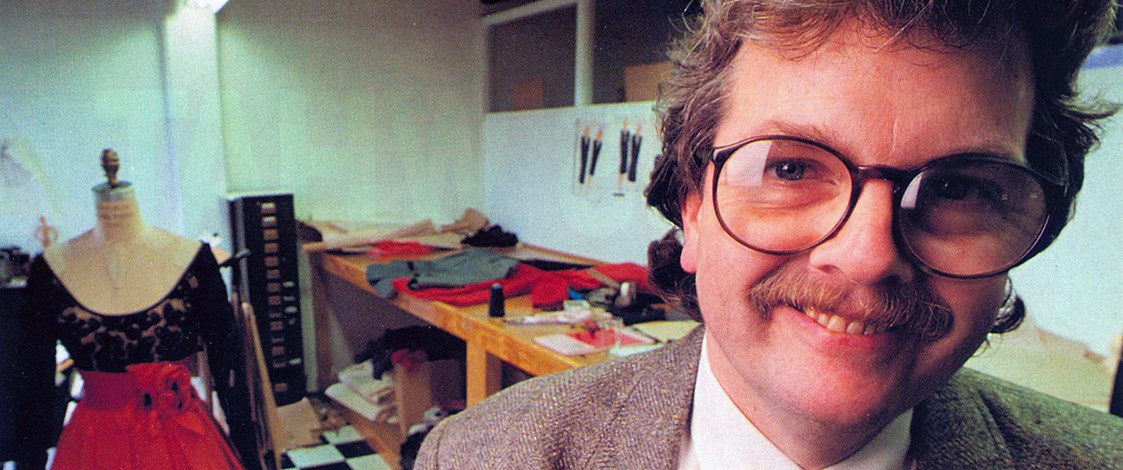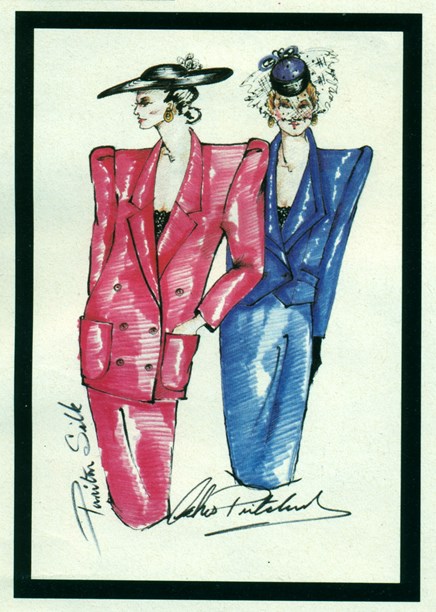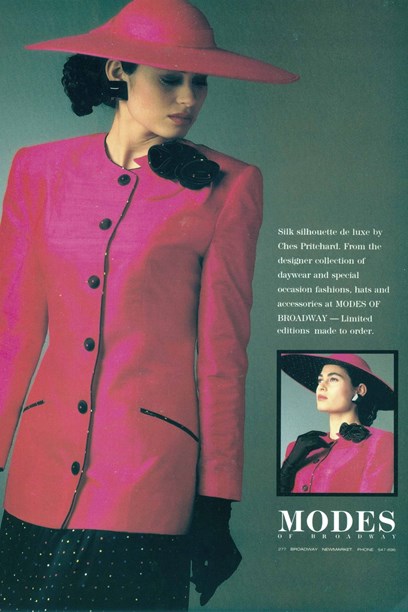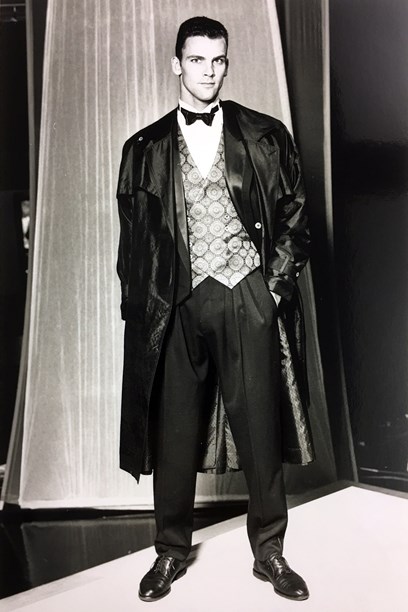Stories
Ches Pritchard
1946–

Ches Pritchard remembers saying in a magazine interview in the 1980s that he would gladly make a dress for Dame Edna Everage if ever she remarried. "I was making the point," he says, "that I was always up for a challenge. I never wanted to be tied down into a position where I couldn’t diversify."
The English-born designer of sophisticated day and eveningwear, and winner of the 1989 Benson & Hedges Fashion Design Menswear Award, drifted into fashion via art college in Southport and Liverpool, where he spent five years in the 1960s studying for his National Diploma of Design.
His first job, as a designer/pattern maker, was with a company that manufactured clothes for British catalogues and chain-stores. "The volume of garments they produced was enormous," he says. "50,000 dresses, for example, in one particular style. It brought home to me that the garment industry isn’t called an industry for nothing. No matter how creative you are, you have to produce garments that sell."
Before emigrating to Toronto in Canada in 1975, Ches owned a fashion boutique in Liverpool, for which he designed most of the clothes. In Toronto, he had his own designer label. Nominated by the Design Council of Canada to exhibit a collection of his work at the Canadian National Exhibition in 1977, he received the Young Designer of the Year Award. One of his mentors during this time was a sample-maker who had worked for Chanel in Paris. "Elsa used to talk to me," he recalls, "about the conversations she had with Chanel regarding garment construction and fit."
Shortly after arriving in Auckland in 1982, Ches Pritchard was appointed head designer at Silk Degrees, a new company producing medium-priced clothing for the younger market. "Silk Degrees was basically a dress label," he says. "We made a lot of party wear."
Four years later, Ches was approached by Brian Hall of Thornton Hall. The company had recently acquired the conservative Puritan label and Ches’s directive was to work alongside creative director Isabel Harris to give it more polish and presence. "We took that tired old label," says Ches, with pride, "and turned it into a collection of seasonless pieces that were stylish and modern without being super-trendy. It was very successful and sold really well."

Ches Pritchard sketch for Puritan silk suits, 1987. Image © Ches Pritchard.
The next call came from Peppertree where Ches spent one year as head designer, working on the fashion ranges and in the company’s corporate wardrobe division. During that time, he designed the $100,000 wardrobe for the Fisher & Paykel crew in the 1989/1990 Whitbread round-the-world yacht race. Comprising 15 items of clothing for each crew member, it included outfits for all occasions from scrubbing the decks to socialising.
After leaving Peppertree, Ches Pritchard formed The Uniform Design Company in partnership with a former Thornton Hall colleague. The venture lasted two years. Clients included Thomas Cook, Whitcoulls and the Toyota dealer network.
With his reputation for good design and workmanship growing, due to his participation and success in the Benson & Hedges Fashion Design Awards, Ches concluded that his future lay in couture. Until taking up fashion tutoring posts, at Auckland’s NZ Institute of Fashion Technology in 2000, followed by the School of Fashion at Otago Polytechnic in 2002, he worked from then on, designing and constructing one-off creations for private clients, special fashion events and fashion magazines. Embroidered in gold thread on black satin, his label read 'Ches Pritchard Couture'.

Ches Pritchard Couture silk dupion jacket and soft-pleated skirt in silk crepe de chine with random multi-coloured spots. Modes of Broadway advertisement, circa 1992. Image © Ches Pritchard.
In 1986, the first year he entered the Benson & Hedges Fashion Design Awards, Ches received two nominations in the After-Five High Fashion category. One was for a 1950s-style ballerina-length dress in red moire taffeta, the other for a silver Lurex ballgown, subsequently worn by an entrant in that year’s Miss New Zealand pageant. The following year, he received two more nominations, and in 1989 won the Menswear Award. His black wool barathea tuxedo (much of it made by hand in true Savile Row tradition), black silk dupion trench-coat and peacock blue and black silk jacquard waistcoat, so impressed the judges they said he came close to winning the Supreme Award. "One of my unrealised ambitions was to have my own menswear label," he says. "Winning that award validated for me that I did have the ability to design high quality men’s clothing." The last time Ches entered the Awards, in 1990, his menswear co-ordinates made it through to the final three.

In 1989, Ches Pritchard won the Menswear Award at the Benson & Hedges Fashion Design Awards with this barathea tuxedo, silk dupion trench coat and silk jacquard waistcoat. Photo © Barry Durrant, from Alexander Turnbull Library, Wellington, Ref: PAColl-6428-08.
Ches was frequently called upon to design special garments for fashion spreads in Fashion Quarterly and More Fashion and he says the publicity generated from this exposure was invaluable. Television also came calling. Suzy Aiken, host of the television show Blind Date, and Penelope Barr, who presented the Corbans Fashion Collections for TVNZ, were among those who wore Ches Pritchard Couture on camera.

Ches Pritchard silk suit designed for a Fashion Quarterly fashion shoot in 1989. The flying saucer hat is by Pagon Millinery. Image © Fashion Quarterly.
The Corbans Fashion Collections, staged annually in the early 1990s, provided Ches with the opportunity to liberate his inner showman. Primarily a platform for fashion manufacturers to present their seasonal ranges, the show’s finale featured themed collections by individual designers. "It was pure fantasy," he says of his sexy black and gold evening collection and the Royal Ascot-inspired race-wear collection in orange, purple and hot pink. "The garments weren’t commercially viable but they were such fun to make."
Ches Pritchard designed some of his most show-stopping creations for the Corbans Fashion Collections. The evening gowns he sent down the runway in 1992 exemplified his use of sumptuous fabrics.
Ches (short for Chesley) Pritchard retired in 2012, having spent the previous ten years teaching pattern-making, garment construction and drawing at the Otago Polytechnic’s School of Fashion. "For me, teaching was both satisfying and fulfilling," he says. "It enabled me to give something back to an industry that had treated me kindly for so many years."
Text by Cecilie Geary. Banner image © Southern Skies magazine, September 1991.
Last published March 2014.